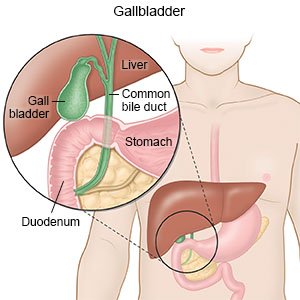Biliary Colic
Medically reviewed by Drugs.com. Last updated on Apr 6, 2025.
What is biliary colic?
Biliary colic is severe pain in your upper abdomen caused by a gallbladder problem. Your gallbladder stores bile, which helps break down the fats that you eat.
 |
What causes biliary colic?
Biliary colic happens when something blocks the duct that moves bile out of the gallbladder. Any of the following can cause blockage:
- Gallstones
- Swelling of the gallbladder
- Narrow bile duct
- Injury
- Pancreatitis (inflammation of pancreas)
- Duodenitis (inflammation of small intestine)
- Spasms in the esophagus
What increases my risk for biliary colic?
- Family history of biliary colic
- Certain medicines, such as birth control
- Older age
- Pregnancy
- Obesity
- Medical conditions, such as liver cirrhosis or hemolytic disease
What are the signs and symptoms of biliary colic?
- Pain in the middle of your upper abdomen, just below your breast bone
- Pain that is worse on your right side, just below your ribs
- Pain in your back, just under your shoulder blade
- Nausea and vomiting
- Pain after you eat a meal
Drugs used to treat this and similar conditions
Actigall
Actigall is used for gallbladder disease, primary biliary cholangitis
Ozempic
Learn about Ozempic (semaglutide) for type 2 diabetes treatment, weight management, cardiovascular ...
Urso Forte
Urso Forte is used for gallbladder disease, primary biliary cholangitis
Reltone
Reltone is used for gallbladder disease, primary biliary cholangitis
Chenodiol
Chenodiol systemic is used for cerebrotendinous xanthomatosis, gallbladder disease
How is biliary colic diagnosed?
- Blood tests check for what is causing your biliary colic.
- Urine tests check gallbladder function.
- An x-ray of your abdomen may help determine what is causing your biliary colic.
- An ultrasound uses sound waves to show pictures on a monitor. An ultrasound may be done to show blockages or other causes of your pain.
- A CT scan , or CAT scan, is a type of x-ray that uses a computer takes pictures of your abdomen. The pictures may show a blockage or other causes of your pain. You may be given a dye before the pictures are taken to help healthcare providers see the pictures better. Tell the healthcare provider if you have ever had an allergic reaction to contrast dye.
- An MRI is a scan that uses powerful magnets and a computer to take pictures of your biliary system. An MRI may show blockages or growths. You may be given dye to help the pictures show up better. Tell the healthcare provider if you have ever had an allergic reaction to contrast dye. Do not enter the MRI room with anything metal. Metal can cause serious injury. Tell the healthcare provider if you have any metal in or on your body.
How is biliary colic treated?
- Medicines can help decrease pain and muscle spasms. You may also need medicine to calm your stomach and stop vomiting.
- Procedures may be needed to remove blockages or widen your bile duct. Ask your healthcare provider for more information about any procedures you may need.
Treatment options
The following list of medications are related to or used in the treatment of this condition.
How can I manage my symptoms?
- Avoid alcohol. Alcohol can damage your gallbladder and make your symptoms worse.
- Maintain a healthy weight. Ask your healthcare provider how much you should weigh. Ask him to help you create a weight loss plan if you are overweight.
- Eat a variety of healthy foods. Healthy foods include fruits, vegetables, whole-grain breads, low-fat dairy products, beans, lean meats, and fish. Foods that are high in fiber and low in fat and cholesterol may decrease your symptoms. Ask if you need to be on a special diet.
- Exercise. Ask your healthcare provider about the best exercise plan for you. Exercise may help improve your symptoms.
When should I contact my healthcare provider?
- You have a fever.
- Your pain gets worse, even after you take medicine.
- You have nausea or are vomiting.
- Your skin or eyes are yellow.
- You have questions or concerns about your condition or care.
When should I seek immediate care or call 911?
- You have severe pain.
- You feel like you are going to faint.
- You are short of breath.
Care Agreement
You have the right to help plan your care. Learn about your health condition and how it may be treated. Discuss treatment options with your healthcare providers to decide what care you want to receive. You always have the right to refuse treatment. The above information is an educational aid only. It is not intended as medical advice for individual conditions or treatments. Talk to your doctor, nurse or pharmacist before following any medical regimen to see if it is safe and effective for you.© Copyright Merative 2025 Information is for End User's use only and may not be sold, redistributed or otherwise used for commercial purposes.
Learn more about Biliary Colic
Treatment options
- Medications for Acute Abdomen
- Medications for Biliary Obstruction
- Medications for Cholangitis
- Medications for Cholelithiasis with Obstruction
- Medications for Gallbladder Disease
- Medications for Gallstones
Care guides
- Abdominal Pain
- Abdominal Pain in Children
- Acute Abdominal Pain
- Biliary Dyskinesia
- Chronic Abdominal Pain in Children
- Gallstones
- Infant Colic
Symptoms and treatments
Further information
Always consult your healthcare provider to ensure the information displayed on this page applies to your personal circumstances.
